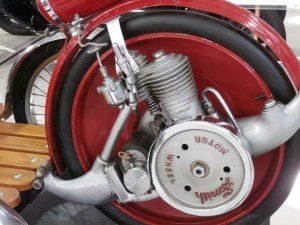The Smith / Briggs and Stratton Flyer Cycle Car originated with the Smith Motor Wheel. The car featured here is the 1920 model.

Smith Motor Wheel and the American Cycle Car
The founder of Smith Precision Products Company located in Milwaukee, WI, Reuben Stanley Smith, filed seven patents between the years 1914 and 1917.
His patents were for a device he called a Motor Wheel. The Smith Motor Wheel was a device attached to the side of a bicycle. The Motor Wheel consisted of an engine and a wheel. Reuben Stanley Smith is remembered as a fascinating inventor known as the inventor of record for various machines and equipment.
You could say this device made the bicycle powered, similar to what we call a moped, with the exception that a had the engine mounted on the bike frame. In many respects the cycle car is a cousin to to both the bicycle and the motorcycle. The Smith Motor Wheel used as power for a bicycle was manufactured from 1914 to 1917.

During this period, automobiles were still a novelty, and prices were of such that only the wealthy could purchase one. The Cycle Car, while different and more primitive, still was a mode of transportation and much more affordable. Smith Precision Products built their Cycle Car based on the Smith Motor Wheel from 1917 to 1920.
It’s estimated that the about 25,000 Smith Motor Wheels were produced from 1914 through 1919.
Briggs and Stratton Cycle Car
There were many cycle cars manufactured. Some put the total at around 125. One manufacturer that stands out in addition to the Smith / Briggs and Stratton is the Morgan Motor Company. Morgan produced the three wheel Morgan Aero and still produces cycle cars today.
Smith Precision Products built the Smith Flyer Cycle Car from 1917 to 1920 after purchasing the rights for the Wall Motor Wheel from Surrey, England. Wall had developed an attachment to bicycles in 1902. The Wall Motor Wheel was attached to the back of the bicycle which allowed for banking during turns. The Smith Motor Wheel was a device with several modifications to the Wall Motor Wheel. The Smith Cycle car was well accepted and eventually have it’s rights purchased.
The Briggs and Stratton Company, who purchased the manufacturing rights for the Motor Wheel and the Smith Cycle Car, produced Flyer cycle cars from 1920 to 1923. Just about all aspects of the Smith Cycle Car were seen on the Briggs and Stratton models. The Smith / Briggs and Stratton Flyer Cycle Car as featured in this article had a buckboard and two buckets seats. An interesting side note is that the Smith Motor Wheel was the basis for Briggs and Stratton developing their power lawn mowers.
As part of the car was a fifth wheel, shown above, placed at the rear. The fifth wheel was hooked up with a single cylinder air-cooled engine and delivered two horsepower. The Briggs and Stratton fuel tank carried one-half gallon of gasoline. The mileage was advertised as 40 to 50 miles. Speed was estimated at 15 MPH. The vehicle sold for $175. Briggs and Stratton marketed their Flyer Cycle Car to a young audience, similar to a motorcycle audience. Typical advertisements for this vehicle suggested…”Just imagine traveling 100 miles an hour at up to 25 MPH on just one gallon of gasoline“.
You may enjoy the Auto Museum Online articles on the links below…
2013 Morgan 3 Wheeler Limited Edition Superdry
1924 Hydrogen Powered Model T Turbo Depot Hack
Today, the Smith and Briggs and Stratton Motor Wheels are collector items. The Flyer Cycle Cars were popular and some exist today, such as the one featured in this article.
An excellent website that offers a list of American cycle car manufacturers along with their various locations and production dates is …http://www.american-automobiles.com/Cyclecar-Manufacturers.html
(Article aand photos copyright Auto Museum Online)

